There are about 1,350 active volcanoes around the globe, each a reminder of Earth’s restless energy. The volcanic forces in play shape continents, create islands, and transform landscapes in a matter of hours. Volcanoes are powerful natural features. Their peaks rise above clouds, their fertile slopes sustain communities, and their eruptions can spark both destruction and renewal.
In this Remitly guide, we’ll explore some of the most iconic volcanoes around the world, exploring their geology, the fertile soils on their slopes, and the ways people live near and even on them.
The science behind volcanic beauty
Volcanoes are more than mountains with fire inside—they’re dynamic geological features. When magma escapes from beneath Earth’s crust, it flows as lava or erupts with ash and gases. Over millennia, volcanic activity shapes the surface of the planet, creating varied new landscapes.
Different types of volcanoes create unique landscapes. Here are the three most common types:
- Shield volcanoes
Broad, gently sloping structures formed by fluid lava flows. - Stratovolcanoes
Steep, conical peaks built from alternating layers of lava and ash. - Cinder cones
Small, steep hills formed by ash and rock fragments.
Fertility
Eruptions may cause short-term destruction, but volcanic ash eventually breaks down into mineral-rich, fertile soil that supports agriculture. This soil supports vineyards, forests, and diverse ecosystems. Regions like Mount Etna in Italy and Java in Indonesia benefit agriculturally from old volcanic deposits.
Creating new land
Volcanoes also create entirely new lands. Islands such as Iceland and the Hawaiian archipelago exist because of volcanic activity. Even today, eruptions at Kilauea continue to expand the Hawaiian coastline, vividly demonstrating how the land changes over time.
Let’s take a look at some of the planet’s most iconic examples.
Mount Fuji, Japan: the perfect volcano silhouette
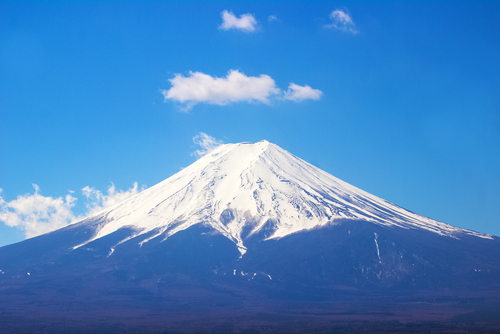
Rising above Honshu, Mount Fuji is Japan’s tallest peak and one of the world’s most iconic volcanoes. Its near-symmetrical cone has influenced centuries of art and poetry, receiving UNESCO World Heritage certification in 2013 for its cultural significance.
Its last major eruption in 1707 covered the area that’s now Tokyo in ash and destroyed nearby villages. While Mount Fuji is currently quiet, the volcano remains active, with small tremors recorded regularly.
Cultural and spiritual significance
People have made pilgrimages to Fuji’s summit for over a thousand years, and shrines have been built at both the base and the crater rim. The mountain is a lasting symbol in Japanese art, famously captured in Katsushika Hokusai’s 36 Views of Mount Fuji, a woodblock series that depicts the peak from various perspectives.
Visiting Mount Fuji
The northern slopes are home to the Fuji Five Lakes, reflecting the mountain’s profile in calm lake waters. Nearby Hakone offers botanical gardens, hot springs, lakeside trails, and amusement parks, making it a year-round destination.
If you plan to climb Fuji, the official season runs July 1 to August 26. Many hikers start at night to reach the summit for sunrise, known as Goraikō, or “arrival of light.” Even in summer, conditions at the top are cold and windy, so bring layers and be prepared.
Santorini, Greece: where destruction created paradise
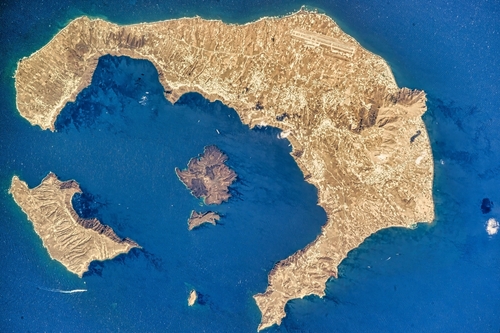
Santorini is a volcanic island in the Aegean Sea, famous for its crescent-shaped caldera, cliff-top villages, and dramatic views. A massive eruption around 3,600 years ago shaped the island’s landscape, when the volcano’s magma chamber emptied and the center collapsed into the sea. Lava flows and ash deposits created its black and red sea beaches.
Cliff-top villages and volcanic beaches
Oia and Fira perch on cliffs above the caldera, featuring blue-domed churches and whitewashed buildings that contrast sharply with the deep blue waters below. Narrow streets reveal how Santorini’s volcanic past shaped architecture and urban planning.The beaches, from Kamari and Perissa’s black sand to the Red Beach’s striking cliffs, offer unique landscapes for photography, relaxation, and nature appreciation.
A still-live volcano
Volcanic activity continues at Nea Kameni, a small islet in the caldera. While eruptions here tend to be minor, volcanologists monitor the area closely to ensure everybody’s safety. And to remind people that this is not an extinct volcano, you can view steaming vents and recent lava formations up close on boat tours.
Kilauea, Hawaii: geological creation in action
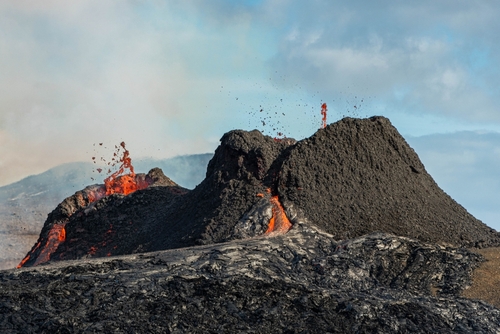
Kilauea, one of the world’s most active volcanoes, sits at the heart of Hawaii Volcanoes National Park on the Big Island. Its Hawaiian name relates to spreading, and reflects how lava continuously flows, creating new land and reshaping the island.
Slow-moving lava forms channels, which are especially striking at night, glowing red hot against the darkness. When the lava reaches the ocean, it creates new black sand beaches while releasing steam and gases, gradually expanding the island’s coastline. You can observe these channels safely from designated viewpoints.
Pele: Hawaiian goddess of fire
Kilauea holds deep cultural significance. Locals honor Pele, the goddess of volcanoes, who embodies both creation and destruction. Hawaiian chants and rituals honor both the spiritual and geological aspects of the volcano.
Visiting Kilauea safely
Hawaii Volcanoes National Park offers trails, overlooks, and visitors centers where you can safely experience lava flows, calderas, and steaming vents. Rangers provide real-time updates on activity, closures, and safety protocols.
If you visit, always stay on marked paths and follow official guidance to protect yourself. It’s easy to get awestruck by this extraordinary landscape but a mistake can be deadly.
Mount Etna, Italy: Europe’s towering fire mountain
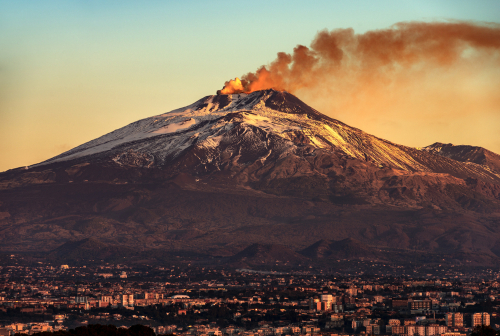
Mount Etna dominates the east coast of Sicily and is the highest and most active volcano in Europe. Throughout its documented history there have been some very large eruptions, like the 1669 blast that destroyed dozens of villages in the region, highlighting its destructive power. In 2013, UNESCO recognized Etna for both its geological and natural significance, and its place in Sicilian culture.
A landscape of extremes
Etna’s scenery ranges from snow-capped peaks to lava streams and dense forests to barren terrain near the summit. Fertile lower slopes support vineyards, citrus groves, and other agriculture, while lava formations provide building material, regulate water, and shelter land. Dramatic features like the Valle del Bove and the Grotta del Gelo enrich the ecosystem.
Mamma Etna
Sicilians call the volcano “Mamma Etna,” viewing it as a maternal figure that nourishes and protects the land. Local legends, including the nymph Etna and the imprisoned Typhoeus, unsurprisingly portray Etna as both a creator and a destroyer.
For locals in the real world, the volcano represents Sicilian resilience and identity. Its fertile soil supports vineyards, orchards, and forests, reflecting the deep connection people have with the volcano that dominates their skyline.
Visiting Etna
You can explore Etna through numerous nature trails, trekking routes, and mountain bike tours. In winter, resorts like Nicolosi and Piani di Provenzana-Linguaglossa give you the chance to go skiing on Etna’s slopes. These experiences are an opportunity to witness the frequent geological activity safely—at least, as safely as you can ever be on an active volcano’s slopes.
Stromboli, Italy: the lighthouse of the mediterranean
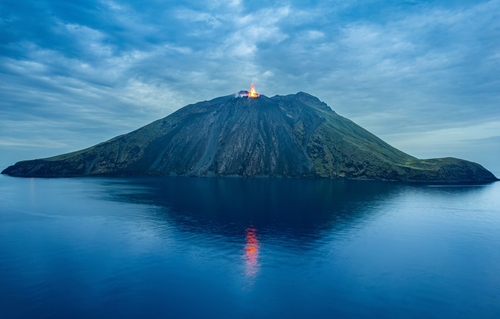
Part of the Aeolian islands off Sicily’s north coast, Stromboli is home to another of the world’s most consistently active volcanoes, erupting almost continuously for over 2,000 years. Called the “Lighthouse of the Mediterranean,” Stromboli’s small, frequent explosions of lava, ash, and gas are so distinctive that volcanologists use the term “Strombolian eruptions” to describe this style worldwide.
Explosions occur frequently, sending glowing fragments skyward, but rarely producing catastrophic flows. This makes Stromboil one of the few places where volcanic activity can be safely observed under controlled conditions.
Life on the island
A few hundred residents live in villages at the foot of the volcanic slopes, their whitewashed houses clinging to the coast. For locals, the volcano is both a risk and a source of identity and income, shaping local traditions, tourism, and daily life. You can watch the glowing eruptions from village viewpoints or boats offshore.
Arenal, Costa Rica: tropical volcanic majesty
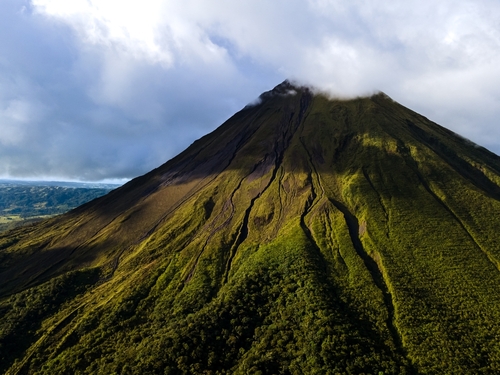
Rising 5,357 feet in northern Costa Rica, Arenal Volcano was once one of Central America’s most active volcanoes, drawing visitors from worldwide with its dramatic eruptions. Dormant since 2010, scientists keep it closely monitored for any signs it’s waking up.
Hot springs and pura vida relaxation
One of Arenal’s greatest gifts lies in the hot springs that bubble at its base. Heated by underground volcanic activity, these mineral-rich waters are celebrated for their therapeutic properties. Resorts and natural pools throughout the region give you a chance to experience the volcano’s energy in a different way and get a taste of Costa Rica’s pura vida lifestyle.
Ecosystem
Just like Etna, Arenal’s volcanic soil has been enriched by centuries of ash and lava and created an exceptionally fertile environment. The surrounding Arenal Volcanic National Park supports dense rainforest teeming with life. Toucans, parrots, and howler monkeys create a cacophony of noise and rare jaguars stalk the dense vegetation.
Trails wind through lava fields, providing you chances to see waterfalls and panoramic views of the volcano itself.
Living with volcanoes: communities and culture
For many, volcanos are not distant wonders but daily realities. As we’ve seen from the way people make their homes on their slopes, communities around the world have learned to live with both the risks and rewards of volcanic landscapes.
The benefits of volcanic regions
- Fertile soil: Volcanic ash and minerals enrich the soil, creating some of the most productive farmland in the world and supporting crops like coffee in Arenal, wine on Mount Etna, and farmland in the regions surrounding Mount Fuji.
- Geothermal energy: Volcanic heat also powers modern life. Iceland taps into volcanic heat to produce some of the world’s greenest electricity and heating, while Hawaii similarly uses Kilauea’s geothermal system for renewable energy.
- Tourism: Travelers hike Mount Fuji, soak in Arenal’s hot springs, and sail to Stromboli to see glowing eruptions, boosting local economies.
Safety
Living near an active volcano means balancing opportunity with risk. Modern monitoring systems, including seismic sensors, satellite tracking, and gas detectors, help predict eruptions and provide early warnings to local communities.
At Stromboli, Etna, and Kilauea, these systems are critical for protecting nearby communities who live with volcanoes looming over their everyday lives.
Resilience and culture
As we’ve mentioned, despite the risks many people view “their” volcanoes not as threats, but as defining symbols of home. Festivals, myths, and traditions highlight the role of volcanoes in local culture, showing how communities adapt to the risks and make the most of the benefits.
Photographing volcanic beauty safely
Volcanoes are exciting to photograph, but your safety should come first.
- Stay in designated areas. Respect all restrictions and barriers.
- Best times for photos. Sunrise and sunset highlight volcanic silhouettes; nighttime captures glowing lava.
- Gear tips: Use a sturdy tripod for low-light shots. You should wear protective gear if you’re going near ash or steam.
What Are the Volcanoes in the Dominican Republic That Are Worth Exploring?
The Dominican Republic boasts stunning geological formations, including several volcanoes that attract adventurous travelers. Notable sites like Pico Duarte and La Pelona offer breathtaking views and unique ecosystems. To truly appreciate the beauty of these natural wonders, take time to explore and discover dominican republic attractions beyond the beaches.
Respecting nature’s dual nature
Volcanoes are both creators and destroyers. They remind us of Earth’s power to renew itself while challenging us to adapt. When you visit one, by all means appreciate their beauty but respect the risks they carry.
Supporting local communities through responsible tourism helps ensure these regions thrive, too. Staying informed through reputable volcano monitoring sites will deepen your own understanding of what might happen and help keep you safe.
FAQs
How dangerous is it to visit active volcanoes?
It depends on the location. Popular destinations like Mount Fuji or Arenal have strict monitoring and designated viewing areas. Following local guidance goes a long way to ensuring your safety.
What causes the different colors we see in volcanic landscapes?
Minerals such as iron, sulfur, and copper create striking reds, yellows, and greens in volcanic rocks and soil.
How do scientists predict volcanic eruptions?
They track seismic activity, gas emissions, and ground movement. These tools often provide warnings before major eruptions.
Why are volcanic regions often so beautiful and fertile?
Over time, volcanic ash breaks down into nutrient-rich soil, supporting diverse plant life and stunning landscapes.
Which volcanoes are safest for tourists to visit?
Destinations with established infrastructure and monitoring, such as the ones we’ve highlighted in the article above, are generally considered among the safer to visit providing guidelines are followed.